Endosulfan

Endosulfan is an insecticide used on a wide range of crops, including tea, tobacco, grains, cotton, fruits and vegetables. Due to concerns regarding the volatilty, persistence and mobility of the chemical, in 2010 the EPA began a phase out, with all uses being banned by the end of July 2016. Similar bans have been introduced worldwide.
According to the World Health Organization, the primary source of human exposure is through food, but it can also arrive in drinking water as a result of agricultural run-off.
Health Effects of Endosulfan
Endosulfan is highly toxic with acute exposure, with the World Health Organization listing symptoms including “[goose bumps], salivation, hyperactivity, respiratory distress, [diarrhea], tremors, hunching and convulsions.”
Long term exposure has shown affects on the nervous system and kidneys, and it may be an endocrine disruptor. It is not believed to be carcinogenic.
Water Treatment for Endosulfan
According to the EPA, endosulfan may be treated with activated carbon.
Sources: EPA, EPA (2), EPA (3), WHO, Wikipedia, Photo: geograph.org.uk, author: Walter Baxter
Site Index
Filtration Systems
- Aeration for Iron & Sulfide
- Backwashing Filters
(whole house & well units)
- Chlorine & Chemical Injectors
- Countertop Water Filters
- Garden Hose Filters
- Reverse Osmosis, Residential
- Reverse Osmosis, Commercial
- Shower Filters
- Specialty Filters
- Ultraviolet Systems
- Undersink Filters
- Water Softeners
- Whole House Filters
Cartridges
Parts
- Replacement Parts
- Faucets
- Filter Media
- Fittings
- Housings
- O-rings
- Pumps
- Pura UV
- R.O. Parts
- R.O. Tanks
- R.O. Booster Pump
- VIQUA UV